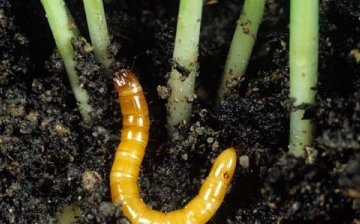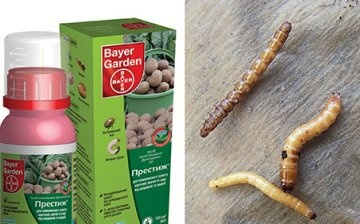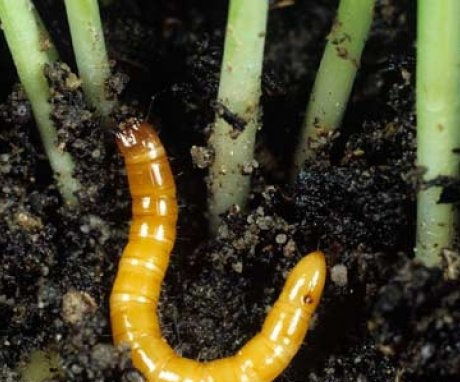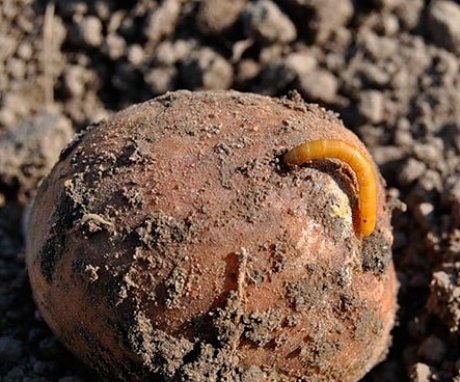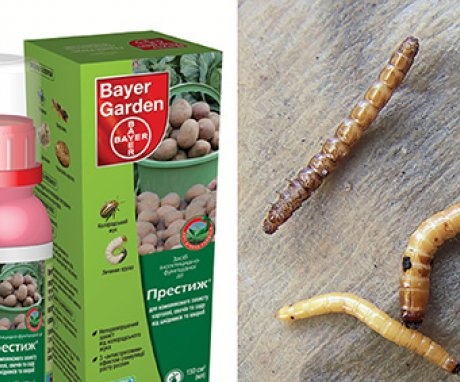How to get rid of a wireworm: effective drugs and alternative methods
The wireworm wreaks havoc on horticultural crops. It can be found on the territory with any type of soil and with any climate. To protect the crop, it is necessary to expel pest from your site or at least reduce its number.
Content:
- Wireworm - pest description
- The harm it does
- Anti-wireworm drugs
- Folk methods of pest control
- Prophylaxis
Wireworm - pest description
The wireworm is not an independent insect: they are the larvae of the click beetle. Outwardly, the wireworm resembles thin worms from 10 to 40 mm long, covered with a shiny yellow-brown chitinous sheath.
The stage of transformation of the larva into a beetle in the wireworm is quite long - 5 years. Three years later, the larva transforms into a pupa, from which a beetle appears next year in the spring.
Both beetles and larvae hibernate in the soil: beetles burrow into the ground to a depth of 15 centimeters, the larvae go 60 centimeters deep.
In April, the beetles begin their years, and from early May to early July they lay their eggs under lumps of earth and in cracks. Egg larvae appear in 2-3 weeks, in the first year of life they reach a length of 7 mm and have not yet become dangerous to plants. Click beetles live on the soil surface or under rotted leaves, straw, live everywhere, but most often on loamy and clayey soils.
The harm it does
Not all types of click beetle larvae harm garden crops; only beetles of the species Selatosomus and Agriotes damage plantings. The wireworm is ruining potato, radish, carrot and other root crops, melons and gourds, young fruit trees, corn and other grains. The problem is that the damage is not immediately noticeable, and the tops of the affected plants may be the same as healthy ones. It is only during the harvest that the damage is discovered.
The pest damages the roots of vegetables and tubers, thereby weakening the plants themselves.
As a result, there is a significant decrease in yield. In addition, fungi and bacteria enter the passages gnawed by a wireworm in root crops, the tubers quickly rot and become unsuitable for storage... Swollen seeds, young roots and stems are also destroyed by this pest.
Anti-wireworm drugs
Description and use of the most effective and popular drugs:
- The most effective drug against wireworm is Bazudin. The product provides a long-lasting effect and has a wide range of activity. The drug is very toxic, dangerous for humans and animals, and therefore I use it only with a very large number of wireworms. Treatment with the drug is carried out only with the use of protective equipment - gloves, mask, glasses - and only in the absence of children and animals. The consumption rate of the drug is 10 - 15 grams per 10 square meters, the agent is introduced into the hole during planting. In combination with "Bazudin" you can use ammonium nitrate or ammonium sulfate at the rate of 25 g per 1 sq. M: the treatment should be carried out 14 and 30 days after planting. This combination of drugs is guaranteed to get rid of the wireworm.
- A less toxic drug with a wide range of action is Diazinon 10% Gr. To combat the wireworm, the drug is used in granular form, it is also introduced into the soil when planting crops.
- Prestige is mainly used to kill the Colorado potato beetle, but it is also effective against wireworms. The drug also has antifungal (fungicidal) properties. Processing "Prestige" is carried out before planting, it is important to carefully read the instructions, since the processing technology for seedlings and potatoes is different. "Prestige" provides protection of tubers and tops for 40 days, at the end of this period the drug is completely deactivated and does not get into young potatoes.
- The unique drug "Metarizin", which is based on sodium gummate, helps to reduce the population of click beetles in winter and spring. Sodium gumate contains natural strains of endomopathogenic fungi that are able to take root in the soil and have a long-term effect on insects. "Metarizin" is used not only as a pest control measure, but also as a growth stimulant and fertilizer... The great advantage of the drug is its harmlessness to humans. "Metarizan" can be diluted in water and spray soil or mix with fertilizers. It is recommended to carry the preparation into moistened soil before digging or hilling.
- The drug "Provotox" is characterized by low toxicity and long duration of action. It is not addictive to wireworms and is harmless to humans, animals, earthworms and microbes. The advantage of "Provotox" is that it does not accumulate in the soil and tubers. "Provotox" is used for planting at the rate of 40 grams per 10 square meters: the granules are evenly distributed in the hole.
- Other insecticides can also be used to get rid of the wireworm: Dohlox, Zemlin, Kapkan, Thunder-2.
Either way, before using insecticides, try alternative wireworm control methods first. They may require more time and labor, but in the end they will pay off in their safety for people, animals and plants.
Folk methods of pest control
Many years of experience in growing vegetable crops based on folk methods of combating wireworms comes to the aid of gardeners. Using baits is one of the most effective and safest ways to get rid of a pest.
Before sowing seeds or planting seedlings:
- Take small potatoes.
- Cut them into pieces.
- Stick a small stick or twig into each piece.
- Bury it in the ground with a cut down to a depth of 10-15 cm.
- After two to four days, take out the bait and destroy the larvae that have stuck into it.
The same pieces can be used many times, you just need to either make a new cut, or moisten the old one with water. After planting, the bait must be laid out between the rows.
The bait can be placed in glass jars, which are buried in the ground in an open form, and pests are removed daily and destroyed.
Small piles of hay or straw can be used as bait for the wireworm, spreading them around the site in early spring. Females will lay eggs under them. In the fall after the autumn digging and in the spring before planting, traps can be made: dig holes in the ground, put rotted leaves and grass there and close the lid. In the fall, with the onset of frost, or in the spring, before planting, remove the contents from the pit and burn it. The use of traps is considered a very effective way of dealing with wireworms.
Half a month before planting vegetables, you can plant swollen seeds in nests (3 pcs. X 1 sq. M.) corn, barley or oats. After sprouting, dig out the bait together with the wireworm and burn.
A good way to get rid of the wireworm for a long time will be planting green manure on the site:
- Peas
- Donnik
- Black beans
- Mustard
- Rape
- Ferocious
- Buckwheat
- Spinach
- Oil radish
- Onion husks or ash placed in the hole when planting potatoes will scare away the nutcracker and its larvae.
The wireworm can be destroyed with ammonium sulfate: during the spring tillage, add the drug at the rate of 25 grams per 1 sq. M. A day before planting seedlings, a weak solution of potassium permanganate (3 g per 10 liters of water) can be poured into the prepared holes. Too saturated solution can damage the planted plants.
Herbal infusions will help get rid of the wireworm:
- Dandelion - 200 g per bucket of water
- Or
- Nettle - 500 g per bucket of water.
This amount of infusion is enough for about 20 holes. Carry out the processing several times at intervals of a week.
Prophylaxis
Prevention of the spread of the wireworm in the area should be carried out in two directions:
- Quarantine measures. They imply a thorough check of the planting material: the wireworm is easily brought into the area with tubers. potatoes.
- Agrotechnical measures: regular loosening of row spacings, destruction weeds, liming, fromturnover of goods, planting wireworm-affected crops after legumes.
The greatest number of wireworms, beetles and eggs perish during the autumn and spring digging of the soil. A good result is loosening the soil in May - July. All detected larvae and beetles must be destroyed, it is better to burn. In autumn, it is advisable to do a deep digging right before the frost, then the larvae and beetles will die from the frost.
Loosening of row spacings must be carried out to a depth of at least 10 centimeters; it is at this distance from the soil surface that the clicker lays its eggs.
Loosening the row spacings prevents the beetles from laying eggs, and the larvae cannot pupate. Clogging of the site with weeds and the density of crops contributes to the active growth of the population of the click beetle. Therefore, it is necessary to destroy weeds throughout the site, especially, this applies to wheatgrass, the roots of which are the wireworm's favorite food.
The wireworm feels good only in acidic soil, therefore, by reducing the acidity of the soil, you can eventually get rid of pest... A decrease in acidity can be carried out by introducing into the soil:
- Lime
- Wood ash
- Crushed red brick
- Coal slag.
The wireworm's digestive system does not readily adapt to a new type of food, so constant crop rotation is a good way to reduce the number of click beetles in the area. Click beetle larvae cannot tolerate legumes such as peas, beans and beans... In areas under such plants, the amount of wireworm is much less than in other places. Therefore, root crops and other crops loved by the pest are recommended to be planted after legumes.
In order not to bring in the larvae of the nutcracker, try not to import land from other sites and do not use rotted or fresh manure in large quantities, which contributes to an increase in the level of acidity of the soil. It is not recommended to plant plants on virgin lands in the first year, which are most affected by the wireworm.
More information can be found in the video.




